Your ultimate guide to durian in Thailand
From the best durian varieties to where to find them, come with us for a spiky, scrumptious feast
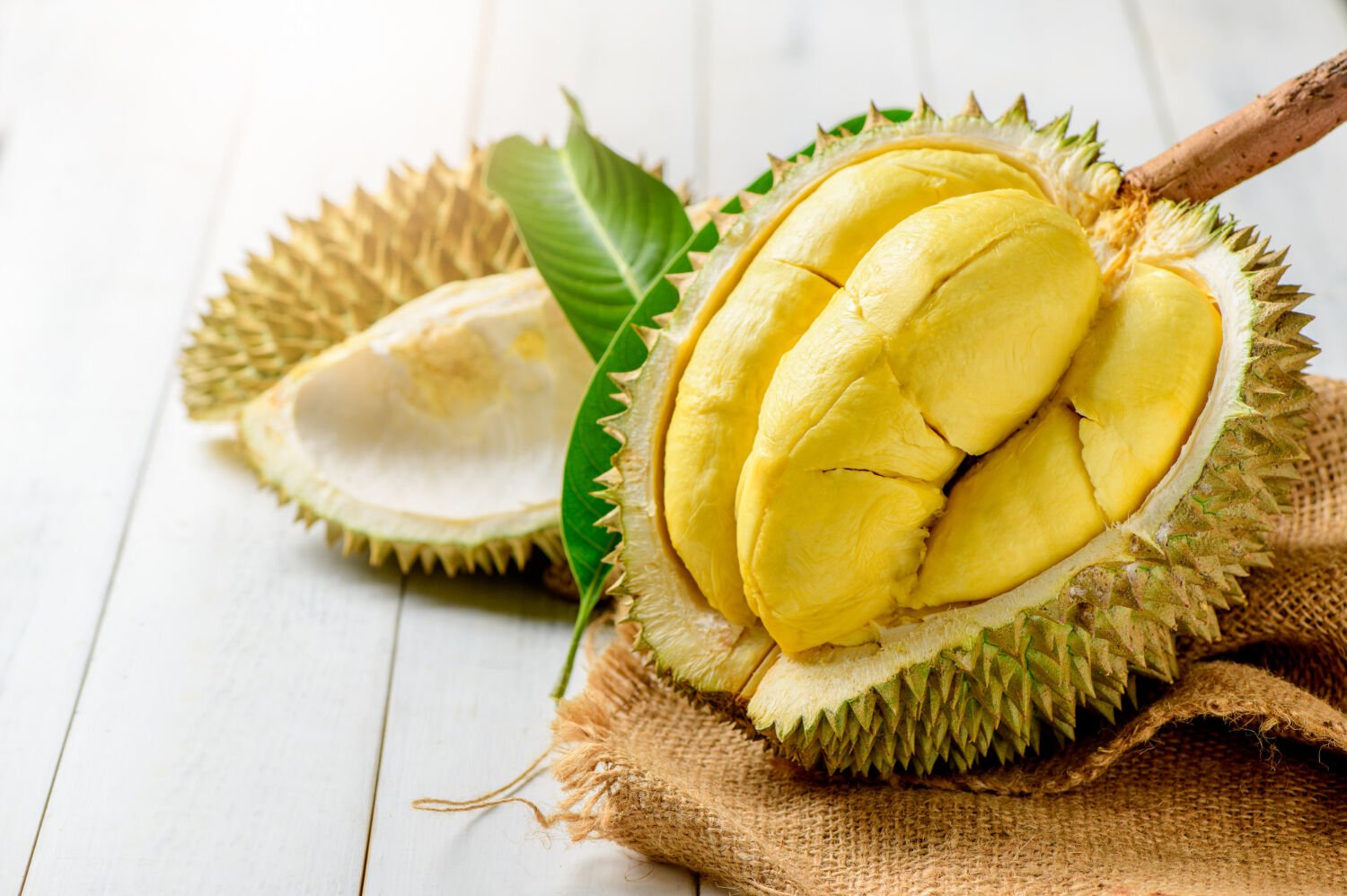
It’s that fabulous time of year again – Durian Season in Thailand! For all you durian lovers out there, isn’t it just the best? And for those who haven’t yet experienced the joy of durian, you’re in for a wild ride! This guide is here to help you kick-start your adventure with the most talked-about tropical fruit, often dubbed the “King of Fruits”.
Hailing from the lush landscapes of Southeast Asia, durian reigns supreme in countries like Thailand, Malaysia, Indonesia, Singapore, and the Philippines. Standing tall and proud, many durian trees can soar to heights of 20 – 50 metres, making them an imposing presence in their tropical home. But it’s not just the trees that leave an impression – the fruits themselves have a unique feature: their spiky, thorny outer shell. Durians look more like a weapon than fruit, and that’s just one of the many reasons they’re so captivating!
Hidden beneath the prickly exterior is a soft, creamy flesh that’s usually yellowish or cream-coloured, with a texture that ranges from firm to soft to mushy, depending on how ripe it is.
Why is durian banned in certain places in Thailand?
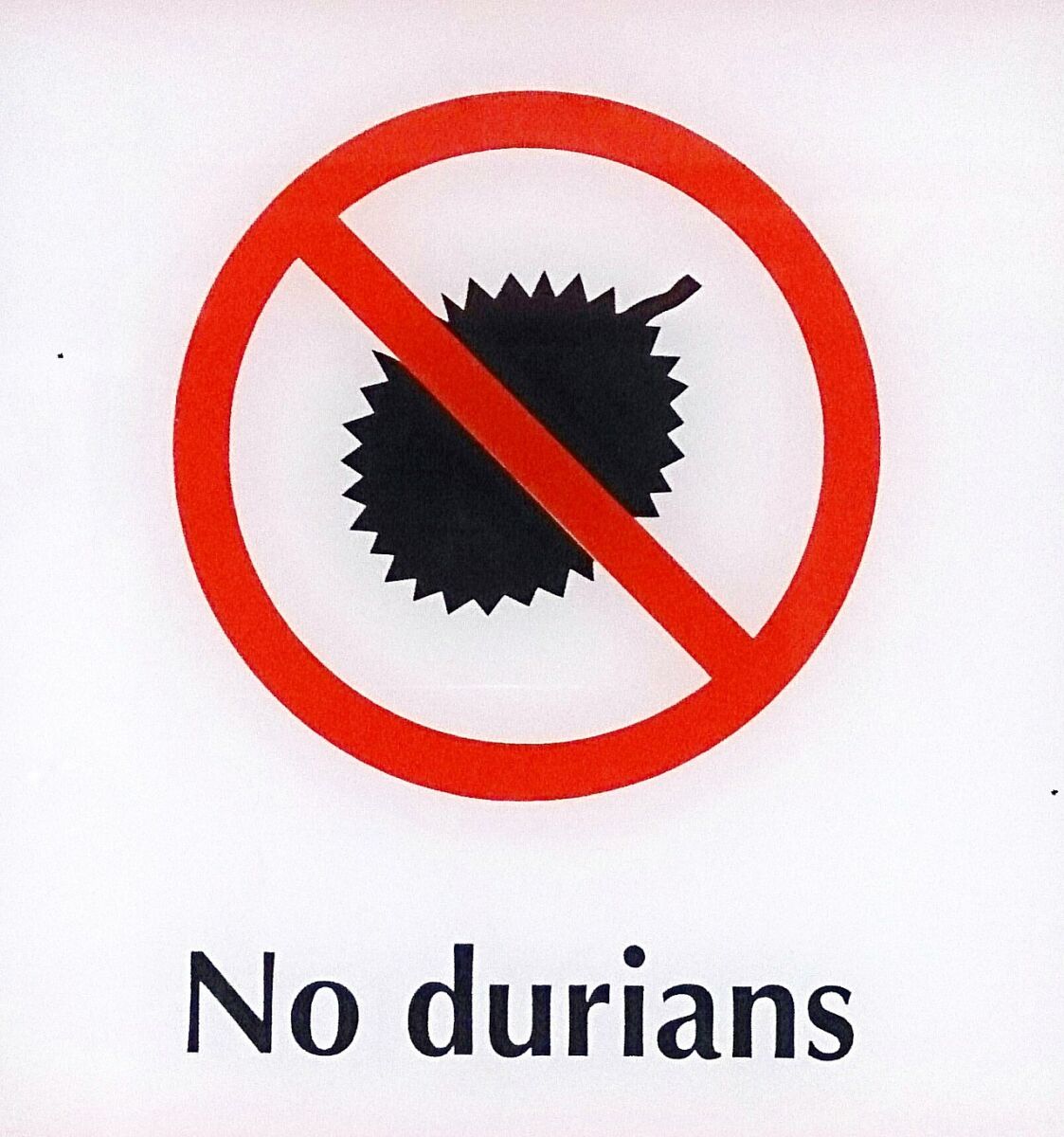
Aside from its unique appearance, durian’s most famous attribute is its distinctive aroma, which has fascinated and polarised food lovers across the globe. Those who can’t stand it might compare the smell to fermented garlic, sewage, or even stinky socks. However, for the durian’s devoted fans, the scent is more like a sweet, intoxicating perfume.
Regardless of whether you adore or abhor the smell, there’s no denying that the aroma can be potent and linger for days. As a result, the durian has earned quite a reputation. And in Thailand (as well as many other parts of Southeast Asia), some hotels, offices, and public places have banned the fruit from their premises due to its overwhelming odour.
So with such a powerful smell, how can people fall in love with durian? Well, for durian enthusiasts, there’s simply nothing that compares to the taste of this fruit. Fans argue that it’s the distinctive aroma and texture of the durian that contribute significantly to the overall taste experience. For those who either adore the smell or can look past it, the flavour of the creamy durian flesh is absolutely delightful, offering a rich medley of tastes that include hints of custard, spices, and almonds. Some durian aficionados even claim that its taste is nothing short of heavenly!
When is the durian season in Thailand?
While durian can be found all year round, the true Durian Season in Thailand shines from April to August. So, should you find yourself basking in the warm embrace of the Land of Smiles during this splendid time, don’t miss the chance to indulge in this iconic fruit. Believe us, the fruit is at its absolute best during Durian Season – fresher, more flavourful, and utterly irresistible!
What are the different Durian varieties Thai people love?
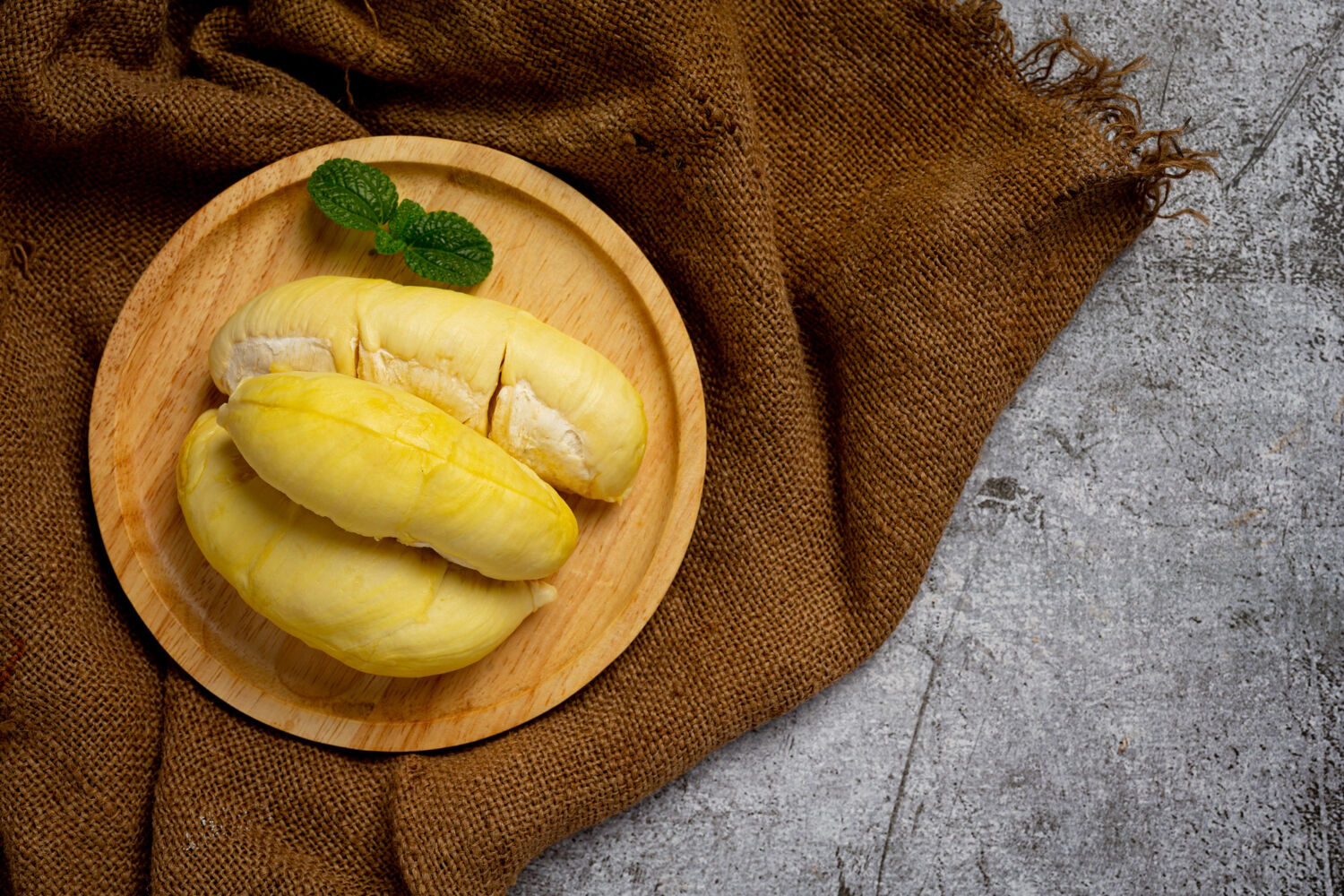
When you spot those spiky delights in shops or along bustling street stalls, you might be baffled by the variety on display. Well, hold onto your hats because there are a whopping 234 varieties registered with the Thai government! Of those, around 60-80 are commercially cultivated.
Now, you might wonder which durian variety dominates the Thai market. Monthong is the undisputed king of the durian world, reigning supreme over its spiky peers. Chanee follows closely behind, with Kan Yau and Gradum-tong also making a respectable showing. The remaining varieties, while not as popular, still charm durian enthusiasts with their unique flavours and quirks.
But what sets these varieties apart, and which one should you sink your teeth into first? With so many varieties available, hunting for good durians isn’t a piece of cake. So, to jump-start your quest for the finest durians, let us introduce you to some of the most sought-after durian varieties in Thailand and what makes each of them truly exceptional.
1. Monthong (The Golden Pillow)
The Monthong holds the prestigious title of Thailand’s most famous and important durian variety. Its name, which translates to “golden pillow” in Thai, hints at the luxurious experience that awaits your taste buds. It’s characterised by its large, elongated, oval-cylindrical shape that tapers at the stylar end and boasts a pronounced beak. Each fruit weighs in at a hefty 2 – 6 kg, with the largest ones reaching up to 10 kg. The rind is thick, adorned with sharp, pointed, small, conical, densely packed spines. Beneath this spiky exterior lies a treasure trove of 10 – 15 arils, each filled with 3 large, thick, creamy, smooth, pale yellow segments of delightful pulp.
The flesh of Durian Monthong is famous for its mild aroma, excellent quality, and meaty texture. The dry and non-sticky pulp only gets sweeter as the fruit ripens, making it a true favourite among durian lovers. With its rich, sweet flavour and minimal pungency, it’s no wonder that Monthong is the most widespread durian variety in Thailand and the top choice for export. If you happen upon a durian outside of Southeast Asia, such as in North America or China, chances are it’s a Thai Golden Pillow. Moreover, the Monthong is an excellent starting point for first-time durian tasters. It offers a gentle introduction to the world of durian with its balanced sweetness and creaminess.
2. Cha Nee (Gibbon)
Next on our list of Thailand’s best durian varieties is the Cha Nee, which translates to “gibbon” in Thai. This fruit is a true delight for those who enjoy a more pungent flavour, as it’s softer, butterier, and stronger in nearly every way compared to the milder Monthong. Its heavier smell and sweet, creamy taste are complemented by a tender yet chewy texture. Interestingly, while it packs a punch in flavour, the Cha Nee is not as rich, allowing enthusiasts to indulge in larger quantities.
When perfectly ripe, the Cha Nee’s flesh turns a beautiful golden yellow, and its luscious aroma intensifies. The meat becomes slightly bitter, adding a magnificent extra dimension to its innate sweetness. The Cha Nee durian’s unique smell and texture make it an ideal candidate not only for eating straight but also for incorporating it into delectable desserts like durian ice cream, smoothies, and sticky rice. In terms of appearance, the Cha Nee sports large, short spikes arranged at wider distances, a thick peel, dark-coloured pulps, and circular small cores.
3. Kanyao (Long Stem)
The Kanyao, or the Long Stem Durian, is medium in size and distinct in appearance. It features a circular shape, thin spikes in close distances, a thick peel, and large circular cores. Its flesh is incredibly sweet, remarkably creamy, and maintains its consistency even when overripe – it never gets too mushy. On the outside,
When selecting a fresh Kanyao durian, look for a thick, hard stem, an undamaged surface, and tightly arranged spikes. Kanyao durians meeting these criteria are considered top quality.
Recognised as the most well-known durian in Thailand, the Kanyao is predominantly cultivated in the Nonthaburi province. With just a handful of farms cultivating this rare variety, its scarcity has secured its position as “the most expensive durian.” It’s a true luxury for your tastebuds. So if you get the opportunity to try it, don’t let it pass you by!
4. Long Lap Lae
The Long Lap Lae, a delightful regional variety, is primarily cultivated in its namesake location – the charming Lap Lae District. Compared to other varieties, the Long Lap Lae is smaller in size, showcasing a circular or oval shape with small cores and a darker pulp. The true magic of this variety lies in its flavour – the sweetness is simply divine. As you savour the chewy and tender pulp, you’ll notice the subtle fibre texture, adding an irresistible depth to each bite.
What sets the Long Lap Lae apart is its mild, floral fragrance, which intensifies as the durian ripens. This delightful aroma is the perfect accompaniment to the fruit’s exquisite taste, offering a sensory experience that is sure to captivate durian lovers.
5. Kradum Thong (Golden Button)
Kradum Thong is a popular variety among farmers due to its low cultivation difficulty and short growing period. This humble durian can be found at most markets, offering an affordable and delightful option for durian enthusiasts.
The Kradum Thong is relatively small in size, with each fruit weighing in at around 1 kilogram. Don’t be fooled by its modest stature, though, as this variety packs a flavourful punch. Its appearance features a relatively dry, dark yellow pulp and large cores, with a smaller portion of pulp compared to other varieties.
The true charm of the Kradum Thong lies in its taste – a heavenly combination of high sweetness and soft texture. Its fragrant aroma only adds to the delightful sensory experience, making it a must-try for durian lovers on a budget.
How to pick fresh durians?
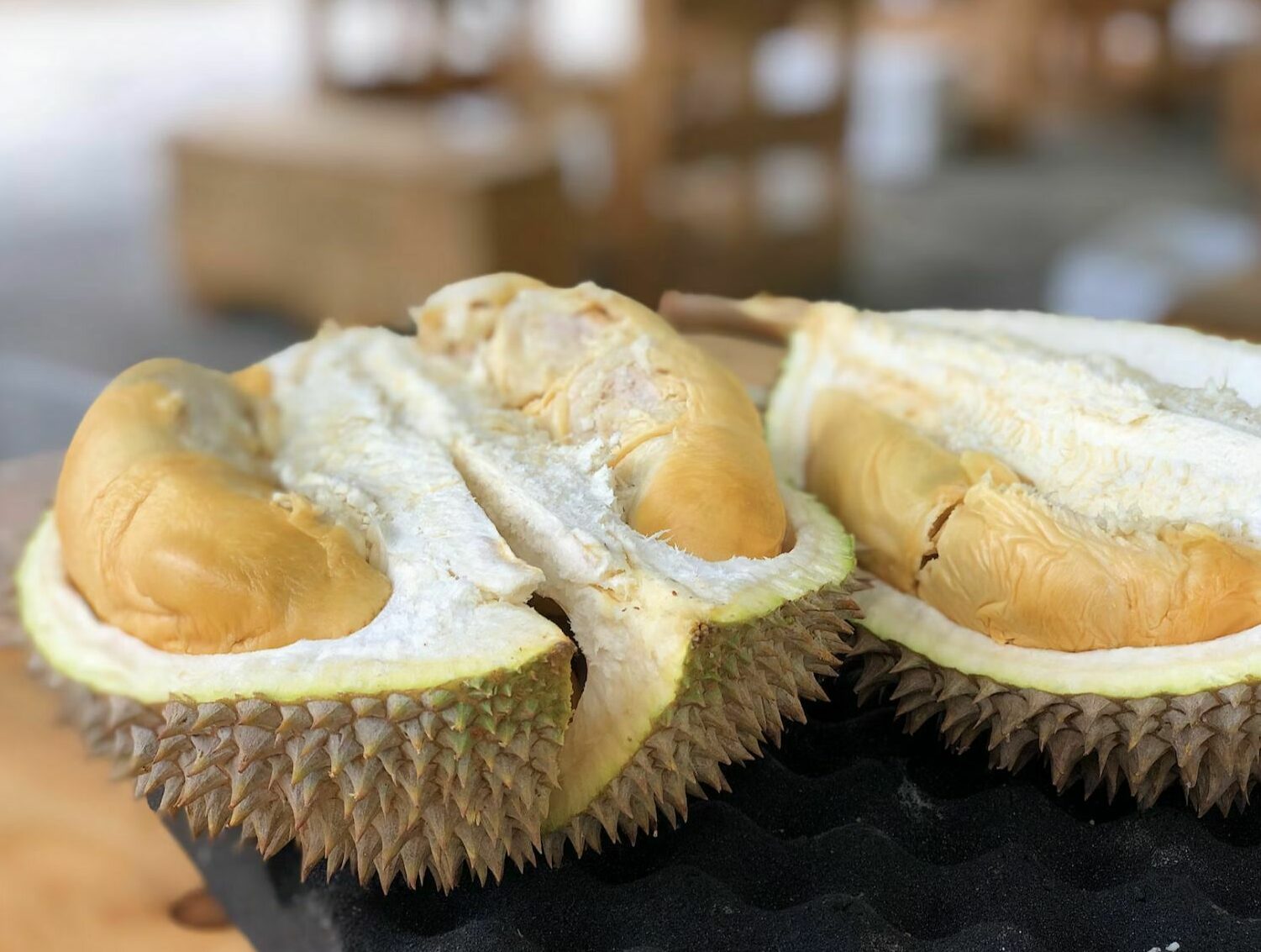
If you’re on the hunt for the tastiest durian, there’s no foolproof method to pinpoint the perfect one. However, there are some tips to help you out.
- First, check the exterior for any signs of critter nibbling or damage from disease – you’ll want it to be nice and clean. Give the stem a little scratch; if it reveals a moist, green surface, that’s a good sign the durian is fresh off the tree. A dry, brown stem means it might’ve been sitting on the shelf for a bit too long. No stalk? Watch out, the seller might be trying to pass off an old durian as fresh.
- Don’t be tempted by a perfectly round durian; the wonkier or curvier ones usually have meatier, creamier flesh with tons of flavour.
- Give the durian’s “seam” a sniff, right near the stem where the spikes naturally face each other and lie flat. If there’s no smell, it’s probably not ripe or very tasty. Too pungent? It could be overripe.
- Vendors often tap on durians to check for ripeness, and you can do it too. Pick it up and give it a gentle shake. A full, ripe durian should sound like a drum, not hollow. You’ll want to hear the seeds moving around just a little inside, but not rattling too much – that means they’ve dried out.
But if you’re still not sure, just ask the vendors. They’ll be more than happy to pick the best ones for you!
Where to buy Durian in Bangkok?
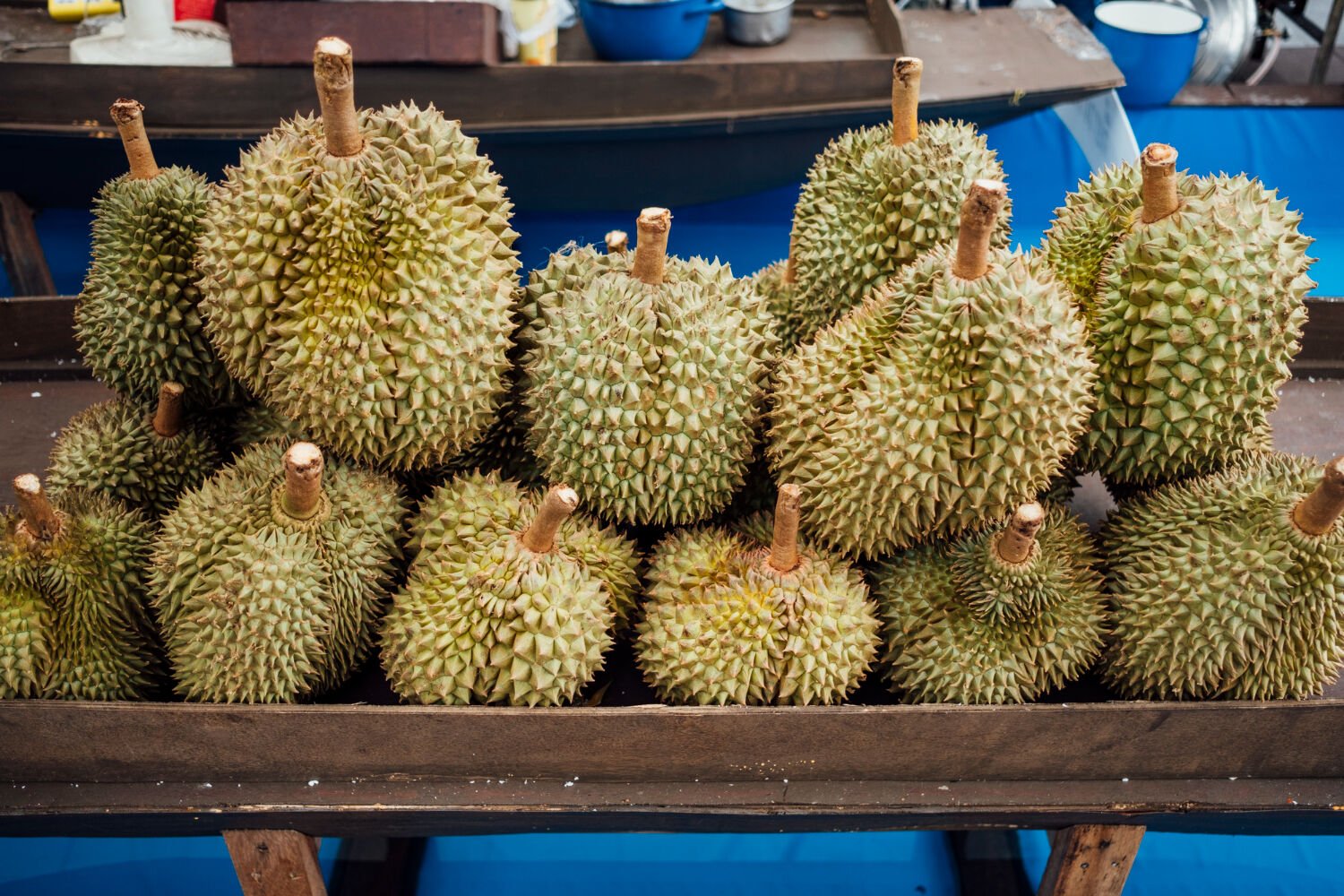
If you want to buy fresh Durian fruit and eat it straight from the shell, here are the best places to go:
1. Durian cart vendors around the City
Bangkok is famous for its bustling streets filled with food and fruit sellers, and durian is no exception. During its season, you’ll find durian practically everywhere you turn. From market stalls overflowing with piles of durian to pushcart vendors proudly showcasing their prized selection, Bangkok’s streets become a durian lover’s paradise.
When durian season hits its peak, you’ll even spot pickup trucks packed to the brim with the cherished fruit, cruising through neighbourhoods while announcing their durian-filled bounty through loudspeakers.
2. Or Tor Kor Market
Or Tor Kor, just a stone’s throw away from the famous Chatuchak Weekend Market, is the go-to spot for all your foodie needs, from fresh goodies to kitchen supplies. And yes, that includes heaps of fantastic durian stacked high at various stalls no matter the time of year. While Kanyao is their speciality, you’ll find all other varieties here. You’ll even find pre-peeled durian wrapped in white paper and neatly packed in styrofoam, all ready for you to enjoy.
3. Supermarket
During durian season, you can snag these spiky delights at pretty much any supermarket. Just like at Or Tor Kor, you’ll find neatly packaged durian ready for you to pick up and take home. It doesn’t get any more convenient than that!
4. Chinatown Bangkok (Yaowarat)
Another place to go to get your durian fix is Chinatown. You’ll usually find some cool street cart vendors and trucks loaded with durian.
Other ways to enjoy durian
Durian’s distinctive charm lies in its incredible versatility. It fits right into all kinds of yummy treats, from savoury bites to sweet desserts. Thanks to its rich, creamy yumminess, durian goes especially well with dreamy ingredients like cream, cream cheese, and coconut milk. This combo seriously takes the durian game to a whole new level of awesome, making your taste buds do a happy dance with every bite. Here are some of the best ways to eat durian:
1. Durian pastries and cakes
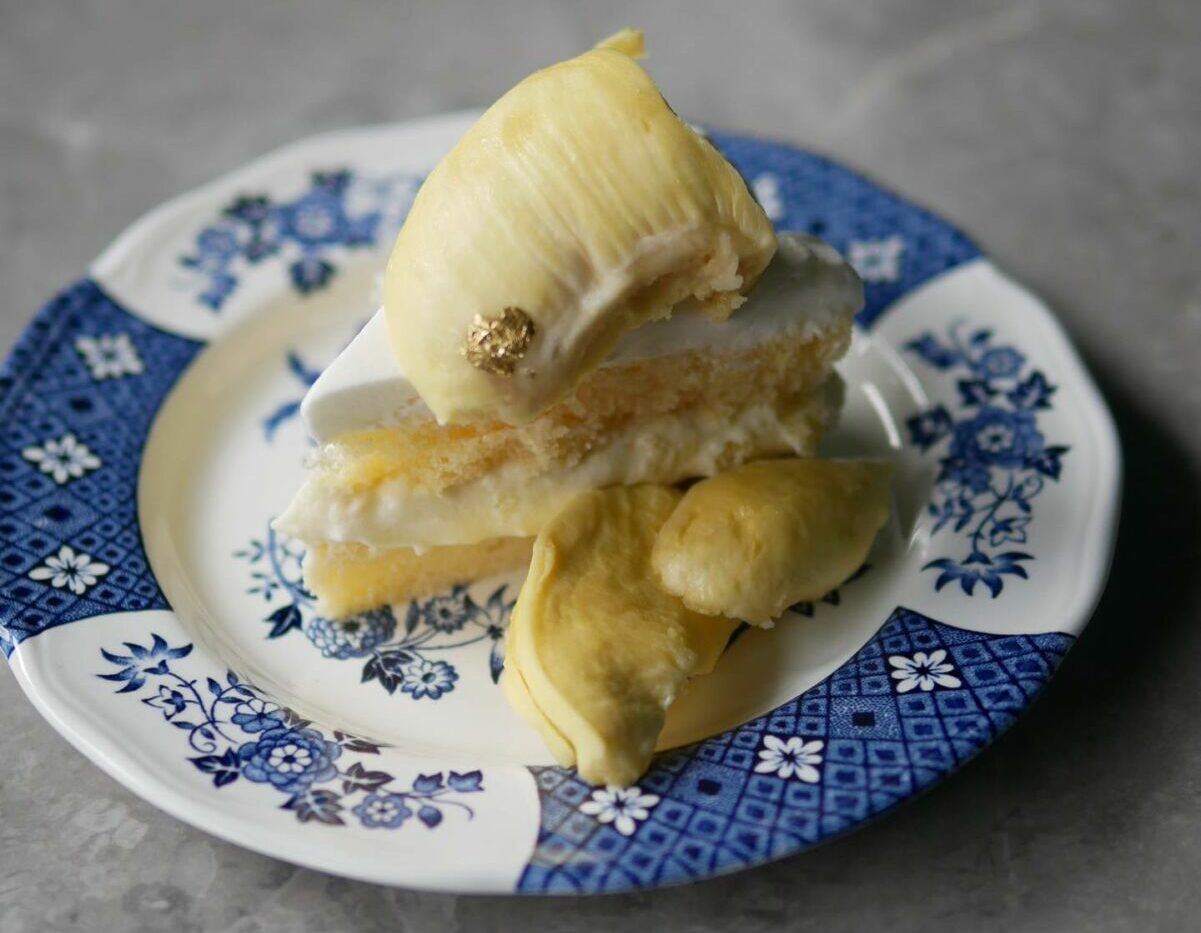
Durian cakes and pastries often feature real fruit purée, packing an amazing durian punch. One place to go for durian cakes and pastries is the Holiday Pastry. Their Durian Cheese Pie comes with creamy cheese and durian topping. Moreover, they have Durian Overload Shortcake, which has layers of sponge cakes, cream, and ripe durian.
Lynx also offers a mouthwatering Durian Cheese Pie featuring a biscuit base, rich cream cheese, homemade durian purée, and large chunks of fresh Durian Mhon Thong.
Another bakery in Bangkok offering durian cake is Brooklyn Baker. Comprised of layers of vanilla cake, whipped cream, and fresh durian, their durian cake strikes a perfect balance with its soft, light textures and subtle fruitiness. It’s an absolute delight for those who prefer a less decadent dessert experience.
2. Durian with sticky rice
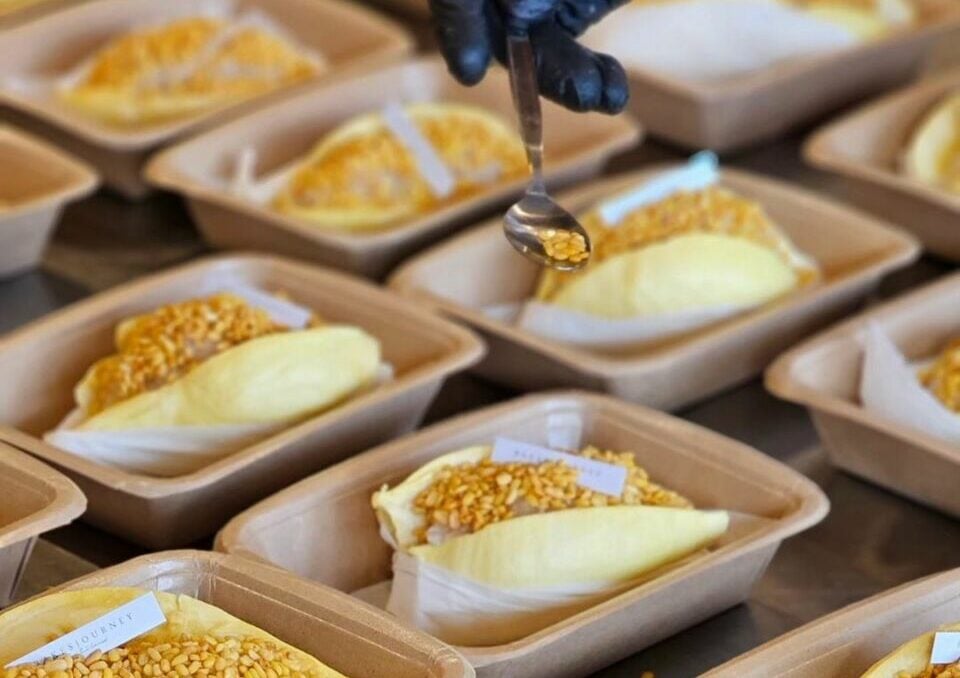
Durian with sticky rice is a top contender among Thai desserts. Just imagine a bowl of sweet sticky rice topped with ripe durian and drenched in delicious coconut cream. Yummm!
When in Bangkok, head to Nara Thai Cuisine for their limited-time Golden Durian with Sticky Rice. This classic Thai dessert combines durian with fragrant coconut milk-soaked sticky rice – and why not add a scoop of ice cream for an extra indulgent twist?
For more durian goodness, check out Bakesjourney, a bakery that has durian lovers swooning over their sweet creations. Their simple yet mouthwatering durian-stuffed sticky rice from Chiang Rai, drizzled with coconut milk, is an absolute must-try.
3. Durian ice cream
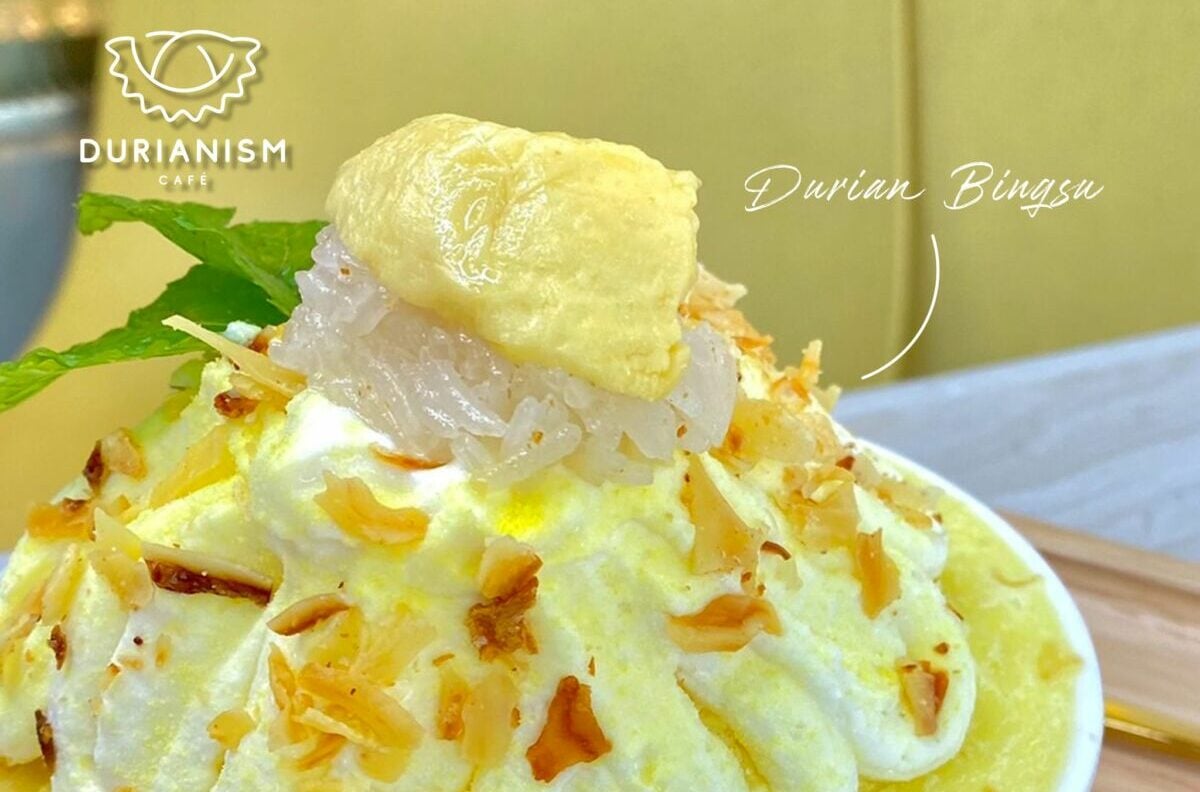
Durian ice cream is another fan favourite – it’s creamy, sweet, and simply delightful! Make your way to Durianism Cafe to give it a try. Their menu is packed with durian-inspired dishes, ranging from savoury to sweet. Among their popular desserts is the Durian Bingsu, featuring durian-flavoured snow, ice cream, sticky rice, and fresh durian.
You should also check out Cheevit Cheeva for some truly drool-worthy durian iced treats. Their Durian Bingsu and Bualoy Durian Bingsu combine Korean-inspired milky bingsu with Thai flavours, drizzled in their special durian sauce. Don’t miss out on their Bualoy Durian Ice Cream as well. It presents a heavenly combo of creamy glutinous rice balls and homemade durian ice cream.
And that concludes our durian guide. A little word of advice, though: best keep durian and alcohol apart, as their pairing might lead to a less than harmonious outcome. Happy durian hunting!
Bought a whole durian fruit, but you’re not sure how to open it? Here’s our guide on how to open durian (and other popular Thai fruits).
Latest Thailand News
Follow The Thaiger on Google News:


























